Making interactive maps with Carto
Introducing Carto
Carto is a cloud-based mapping application that makes it easy to produce interactive, online maps. These maps can include animations of data over time. It is also a geospatial database, allowing you to process geodata using Structured Query Language.
Learning SQL is beyond the scope of this class, but these notes include a couple of simple queries, to filter data and update a dataset with a new calculated variable.
The data we will use
Download the data for this session from here. It contains the following files:
ca_counties_medicare.zipZipped shapefile with data on Medicare reimbursement per enrollee by California county in 2012, from the Dartmouth Atlas of Healthcare.healthcare_facilities.csvLocations and other data for hospitals and other healthcare facilities in California, from the California Department of Public Health. I have geocoded those facilities that lacked latitude and longitude coordinates in the raw data.
Our mapping task
We are going to make a map with two layers:
- Choropleth map showing the Medicare spending per enrollee for care in hospitals and skilled nursing facilities, for each of the 58 counties in California. This data is in the field
hospitalin theca_counties_medicareshapefile. - A map of scaled circles, from the
healthcare_facilities.csvdata, showing the location andcapacityin beds of hospitals and skilled nursing facilities in California. We will also color the facilities by theirtype(general acute care hospital or skilled nursing facility).
Import data to Carto
Login to your Carto account, open the drop-down menu under Maps at top left and switch to Your datasets. Then click the green NEW DATASET button at top right:
You should now see the following screen:

With the Data file tab selected, click the Browse button, navigate to the zipped ca_counties_medicare.zip shapefile and click Open. Then click the green Connect dataset button.
Carto can import geodata in a variety of formats, including CSV, KML, GeoJSON and zipped shapefiles. See here for more on imports and supported data formats.
Once the data has imported, you will see the uploaded data table in DATA VIEW:

Notice that, in addition to the fields from the original data, each row has been given a cartodb_id, which is a unique identifier for each. The table also has a field called the_geom which has the tag GEO. This field is central to how Carto works, defining the geometry of any map you make. These geometries can be points, lines or polygons (areas) — which is what we have here.
You can rename fields, sort the table by the data in them, or change their data type (for example from numbers to strings of text), by clicking the downward-pointing triangle next to the header of each.
Switch to MAP VIEW to see the basic, unstyled map:
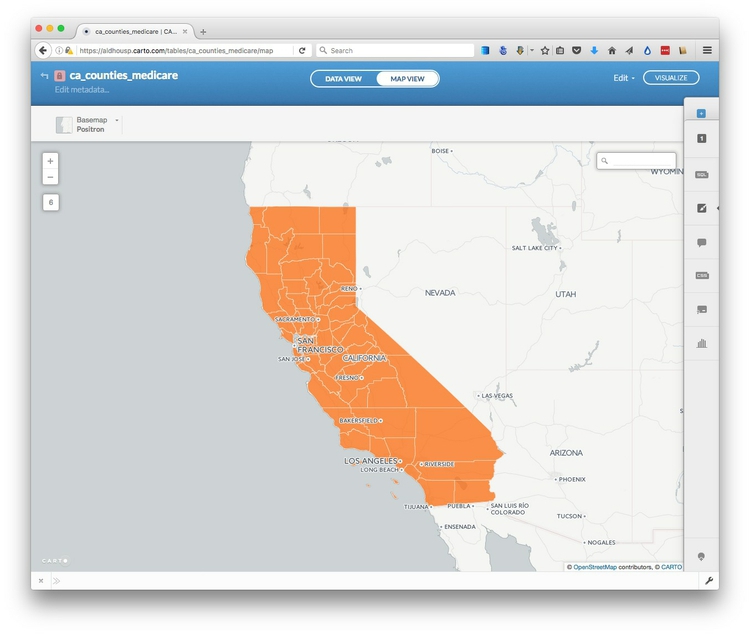
Click the small return arrow at top left to go back to the overview of your datasets.
Notice that the top menu has a link to DOCUMENTATION, which has links to Carto’s technical manuals. The Data library link contains useful datasets that you can import into your own account. Take a few minutes to explore what’s there, before returning to your Datasets.
Now click the New datasets button again and import the file healthcare_facilities.csv, which should look like this in the DATA VIEW:
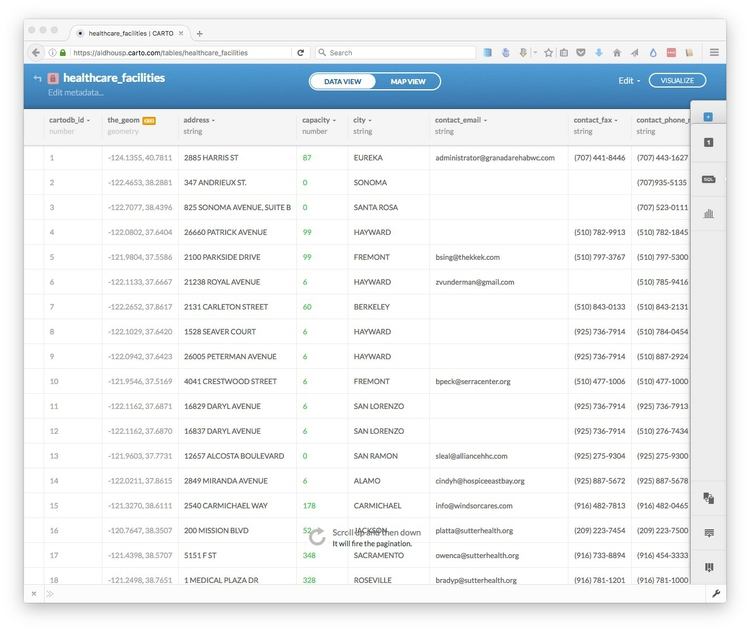
Notice that the_geom for points is given by their longitude and latitude co-ordinates.
Click on the MAP VIEW to see the locations of all of the facilities:

Create a visualization combining both datasets
Exit the healthcare_facilities map and reopen the ca_counties_medicare dataset by clicking on its name in your DATASETS. Then click the VISUALIZE button at top right.
You will then see a prompt to create a new map. Click the green OK, CREATE MAP button:
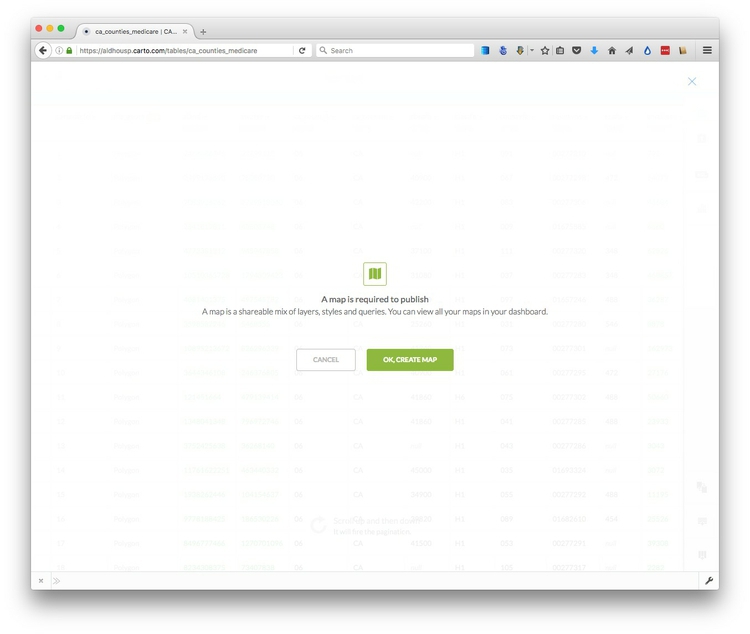
Rename this map California hospitals by clicking on its name at top left:

Now add the healthcare_facilities to the map, by clicking on the blue + button to the right. Select the healthcare_facilities layer so that its icon is highlihgted in blue, then click the ADD LAYER button at bottom right.
Now select MAP VIEW to see both layers on the same map:

You can tell when you’re in a map visualization, rather than a single dataset, because the MAP VIEW has a black border.
Select a basemap
Now choose a basemap for your visualization, by clicking Change basemap at bottom left. Take a few minutes to explore the built-in basemap options. You are not limited to these basemaps, however.
To import another tiled basemap from elsewhere on the web, click the blue plus sign next to Yours to call up the following dialog box:

The XYZ tab allows you to call in publicly available basemaps using URLs in the following format:
https://{s}.tiles.mapbox.com/v3/mapbox.world-bright/{z}/{x}/{y}.png
We will use this “world bright” basemap, provided by MapBox (see the other basemaps from MapBox here). The Leaflet Providers preview is a good place to look for available basemaps from other providers. It previews the maps and also exposes their XYZ URLs:
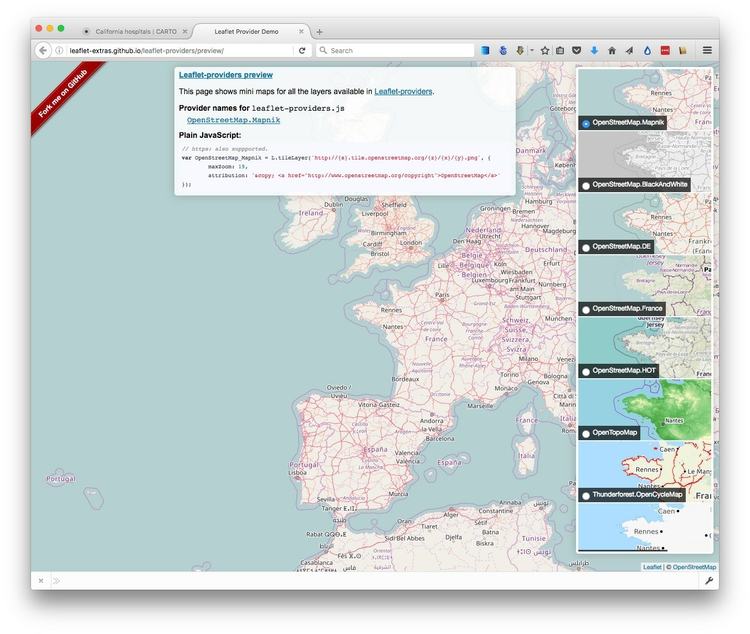
Back in Carto, enter the XYZ URL for the MapBox world bright map and click Add basemap. The map should now look like this:

Style the maps using the Carto wizard
Notice that the toolbar at right has tabs numbered 1 and 2. It you hover over them, you will see that they correspond to the ca_counties_medicare and healthcare_facilities layers respectively.
Click on 1 to expose the Visualization wizard for the ca_counties_medicare layer, which can also be reached by clicking the paintbrush icon:

(You can collapse the wizards at any time by clicking to the left of any of the icons.)
Notice that opening the wizard has also exposed blue toggle controls for each layer, which can be used to turn the visibility for each on and off. Hide the healthcare_facilities layer so we can see what we are doing.
Scroll from left to right through the visualization options, and select CHOROPLETH to make a choropleth map.
Set hospital as the data Column, select 5 Buckets, set them by Quantile and set the Polygon Stroke to zero to remove the lines from the map layer. The map should now look like this:

Now click 2 to switch to the healthcare_facilities layer and turn on its visibility.
In the Visualization wizard select CATEGORY and color the circles by the type of facility, by selecting type as the data Column. The map should look like this:
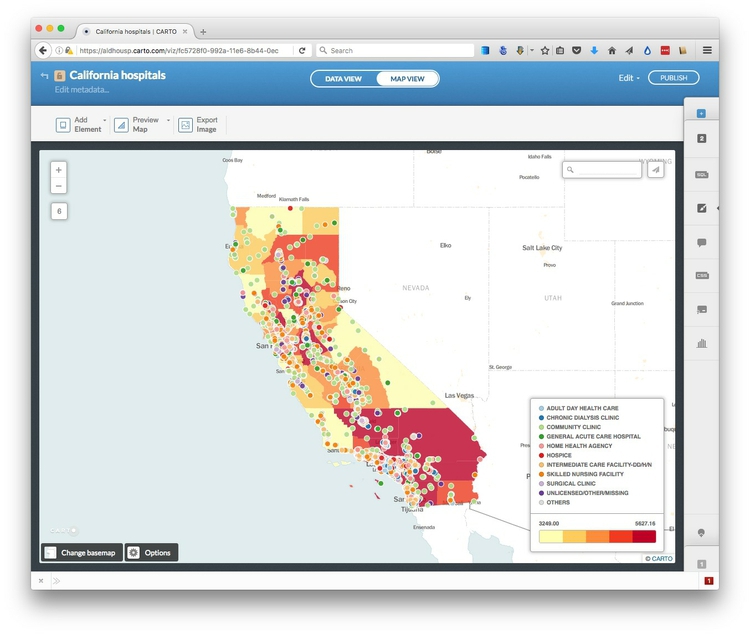
Create a new column in the healthcare facilities data to scale the circles accurately by area, according to their capacity in beds
The Carto Visualization wizard does have a BUBBLE option, which sizes circles according to values in the data. However, it does not accurately and continuously vary the area of circles according to values in the data. To achieve that, we need to create a new column in the data, containing the square root of the values in the capacity column.
This is because web-based applications like Carto set the size of circles by their width, or twice their radius. From day one, you should remember that we need to scale by the square root of the radius to size circles so that their area is proportional to values in the data.
Switch to the DATA VIEW for the healthcare_facilities layer. Open up the dropdown menu for the capacity field and select Add new column... Rename it as scale and then change its type from string to number:

Now open the SQL tab, then enter and apply the following query:
UPDATE healthcare_facilities SET scale=sqrt(capacity)
UPDATE queries change the data in the table, in this case updating the healthcare_facilities table to set the values for scale as the square root of the values in capacity.
Click Apply query and see that the scale column has now been populated with values:
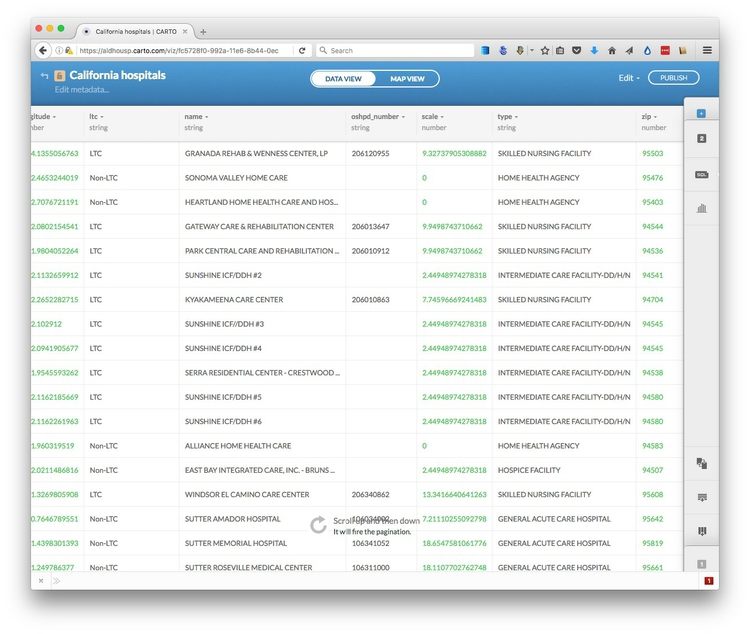
Filter the healthcare facilities data to display only general acute care hospitals and skilled nursing facilities
To filter the data, we can use another simple SQL query. In the SQL tab, enter and apply the following query:
SELECT *
FROM healthcare_facilities
WHERE type = 'GENERAL ACUTE CARE HOSPITAL' OR type = 'SKILLED NURSING FACILITY'
In this query, * is a wildcard that selects every column from the healthcare_facilities dataset. The WHERE clause applies the filter for the specific types we want to retain on the map.
The map should now look like this in the MAP VIEW:

Style the map using CartoCSS
To exert finer control over the map styling, we can use CartoCSS, which styles maps in much the same way that conventional CSS styles web pages. See here for a CartoCSS reference.
In the MAP VIEW, select the ca_counties_medicare layer by clicking on 1. Then click on the CSS icon, where you will see the following code:
/** choropleth visualization */
#ca_counties_medicare {
polygon-fill: #FFFFB2;
polygon-opacity: 0.8;
line-color: #FFF;
line-width: 0;
line-opacity: 0;
}
#ca_counties_medicare [ hospital <= 5627.16] {
polygon-fill: #BD0026;
}
#ca_counties_medicare [ hospital <= 4197.21] {
polygon-fill: #F03B20;
}
#ca_counties_medicare [ hospital <= 3801.62] {
polygon-fill: #FD8D3C;
}
#ca_counties_medicare [ hospital <= 3581.08] {
polygon-fill: #FECC5C;
}
#ca_counties_medicare [ hospital <= 3249] {
polygon-fill: #FFFFB2;
}
Edit this to the following, to reset the breaks between the bins, and to use the same color scheme we used in week 10, using HEX values taken from ColorBrewer
/** choropleth visualization */
#ca_counties_medicare {
polygon-fill: #FFFFB2;
polygon-opacity: 0.5;
line-color: #FFF;
line-width: 0;
line-opacity: 0;
}
#ca_counties_medicare [ hospital <= 5627.16] {
polygon-fill: #a50f15;
}
#ca_counties_medicare [ hospital < 4000] {
polygon-fill: #de2d26;
}
#ca_counties_medicare [ hospital < 3750] {
polygon-fill: #fb6a4a;
}
#ca_counties_medicare [ hospital < 3500] {
polygon-fill: #fcae91;
}
#ca_counties_medicare [ hospital < 3250] {
polygon-fill: #fee5d9;
}
Note that that we have also edited the operators for all but one of the formulas for the breaks from <= (less than or equal to) to < (less then). Click the Apply style button at bottom right.
Now switch to the CartoCSS editor for the healthcare_facilities layer, where you will find the following code:
/** category visualization */
#healthcare_facilities {
marker-fill-opacity: 0.9;
marker-line-color: #FFF;
marker-line-width: 1;
marker-line-opacity: 1;
marker-placement: point;
marker-type: ellipse;
marker-width: 10;
marker-allow-overlap: true;
}
#healthcare_facilities[type="ADULT DAY HEALTH CARE "] {
marker-fill: #A6CEE3;
}
#healthcare_facilities[type="CHRONIC DIALYSIS CLINIC "] {
marker-fill: #1F78B4;
}
#healthcare_facilities[type="COMMUNITY CLINIC "] {
marker-fill: #B2DF8A;
}
#healthcare_facilities[type="GENERAL ACUTE CARE HOSPITAL"] {
marker-fill: #33A02C;
}
#healthcare_facilities[type="HOME HEALTH AGENCY "] {
marker-fill: #FB9A99;
}
#healthcare_facilities[type="HOSPICE "] {
marker-fill: #E31A1C;
}
#healthcare_facilities[type="INTERMEDIATE CARE FACILITY-DD/H/N"] {
marker-fill: #FDBF6F;
}
#healthcare_facilities[type="SKILLED NURSING FACILITY"] {
marker-fill: #FF7F00;
}
#healthcare_facilities[type="SURGICAL CLINIC "] {
marker-fill: #CAB2D6;
}
#healthcare_facilities[type="UNLICENSED/OTHER/MISSING"] {
marker-fill: #6A3D9A;
}
#healthcare_facilities {
marker-fill: #DDDDDD;
}
Edit this to the following:
#healthcare_facilities {
marker-fill-opacity: 0.5;
marker-line-color: #FFF;
marker-line-width: 1;
marker-line-opacity: 1;
marker-placement: point;
marker-type: ellipse;
marker-width: [scale];
marker-allow-overlap: true;
}
#healthcare_facilities[type="GENERAL ACUTE CARE HOSPITAL"] {
marker-fill: #0000FF;
}
#healthcare_facilities[type="SKILLED NURSING FACILITY"] {
marker-fill: #FF8000;
}
Setting the marker-width to [scale], with the name of the field in square brackets, accurately scales the area of the circles according the capacity of the facilities. If necessary, when scaling circles in this way, you can use multiplication (marker-width: [scale]*2;) or division (marker-width: [scale]/2;) to increase or decrease the size of all the circles.
The CartoCSS above also makes the circles semi-transparent using marker-fill-opacity: 0.5;. It makes the hospitals blue using marker-fill: #0000FF;, and skilled nursing facilities orange using marker-fill: #ff8000;.
The map should now look like this:

Edit the legend
Notice that the legend still refers to the styling created by the wizard.
For the ca_counties_medicare layer, click on the legends icon:

Edit the title to Medicare reimbursement per enrollee and check show, change the Left label to <$3,250 and the Right label to >$4,000; then change the colors to those that are now displayed on the map:

Select the </> link to edit the HTML to the following:
<div class='cartodb-legend choropleth'>
<div class="legend-title">Medicare reimbursement per enrollee</div>
<ul>
<li class="min">
<$3,250
</li>
<li class="max">
>$4,000
</li>
<li class="graph count_315">
<div class="colors">
<div class="quartile" style="background-color:#fee5d9; opacity:0.5"></div>
<div class="quartile" style="background-color:#fcae91; opacity:0.5"></div>
<div class="quartile" style="background-color:#fb6a4a; opacity:0.5"></div>
<div class="quartile" style="background-color:#de2d26; opacity:0.5"></div>
<div class="quartile" style="background-color:#a50f15; opacity:0.5"></div>
</div>
</li>
</ul>
</div>
Adding opacity: 0.5 to the styling for each of the legend items makes them match the semi-transparency of the map layer.
Edit the legend for the healthcare_facilities similarly, changing the HTML to the following:
<div class='cartodb-legend custom'>
<div class="legend-title">Healthcare facilities (scaled by capacity)</div>
<p>
<ul>
<li>
<div class="bullet" style="background:#0000ff; opacity: 0.5"></div>
General acute care hospital
</li>
<li>
<div class="bullet" style="background:#ff7f00; opacity: 0.5"></div>
Skilled nursing facility
</li>
</ul>
</div>
Configure tooltips
Select the ca_counties_medicare layer, and click on one of the counties and click the infowindow icon:

In the Hover tab, turn on the hospital toggle control, uncheck title?, then select the </> link to edit the HTML.
Insert a $ symbol in front of {{hospital}}:
<div class="cartodb-tooltip-content-wrapper">
<div class="cartodb-tooltip-content">
<p>${{hospital}}</p>
</div>
</div>
Click Apply and a tooltip showing the medicare reimbursement should now appear when you hover over each county.
Now switch to the healthcare_facilities label, select the infowindow tab, and in the Click tab select the capacity and name toggle controls. This time keep title? checked for each.
The map should now look like this:
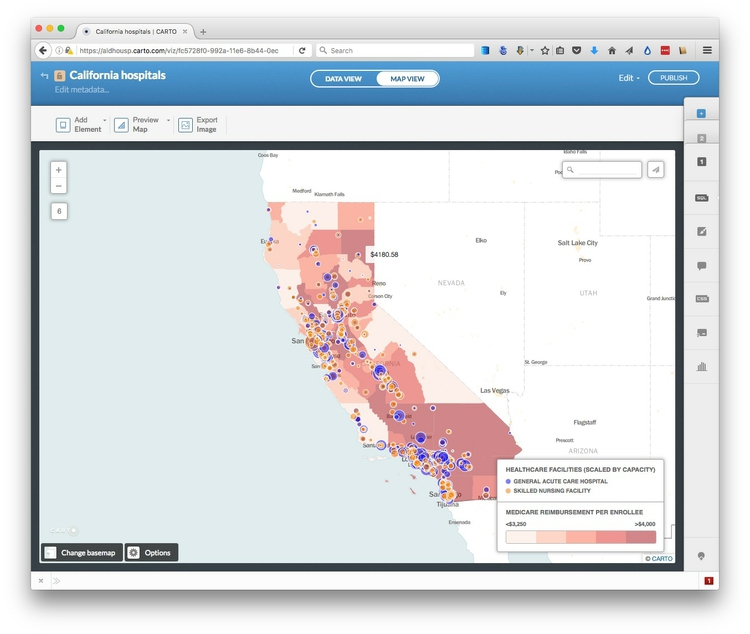
Configure the map options, and publish
We are almost ready to publish the visualization, but before doing so, click Options at the bottom left of the map to select the controls and other items you want to include. Here the Search box, which geocodes locations entered by the user and zooms to them is disabled; the option to switch to a Fullscreen view of the map is enabled:
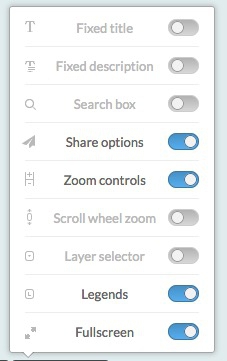
I strongly recommend disabling the Scroll wheel zoom which will otherwise cause the map to zoom unintentionally when someone scrolls down a web page in which the map is embedded.
Also explore the Add Element button at top left, which allows you to add a title and other annotations to your map.
You can also click Preview Map to see you map will look on Desktop and Mobile devices, or Export Image to download a static image.
Having finished working on the visualization, click the PUBLISH button at top right. This will call up the following options:

Copy the code from Embed it to obtain an iframe which will allow you to embed the map on any web page, in the following format:
<iframe width="100%" height="520" frameborder="0" src="https://aldhousp.carto.com/viz/fc5728f0-992a-11e6-8b44-0ecd1babdde5/embed_map" allowfullscreen webkitallowfullscreen mozallowfullscreen oallowfullscreen msallowfullscreen></iframe>
(Note that you can edit the dimensions of the iframe — here set at 100% of the width of the div in which it appears — and 520 pixels high) as required.)
Open the file test.html in your text editor, paste the iframe code between the <body> </body> tags and save the file. Then open in a web browser to see the completed map:
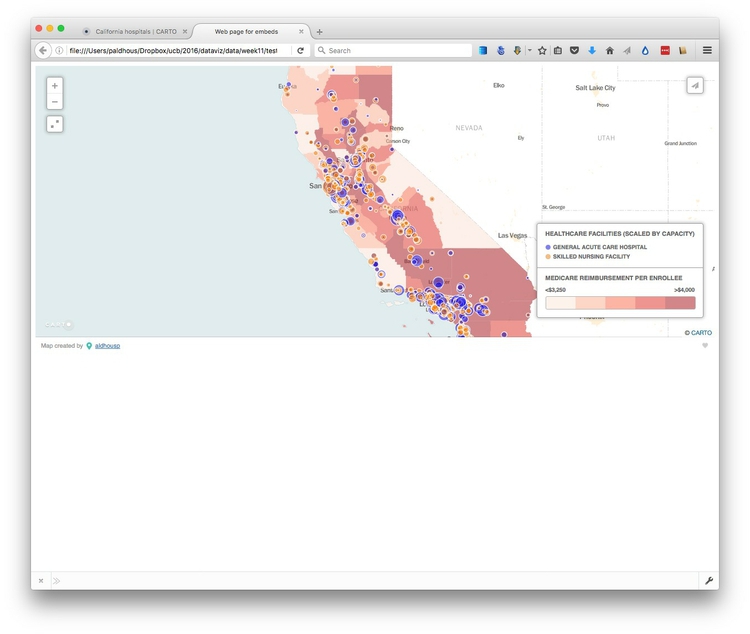
Further reading/resources
The Map Academy
A series of exercies in Carto, organized by difficulty.